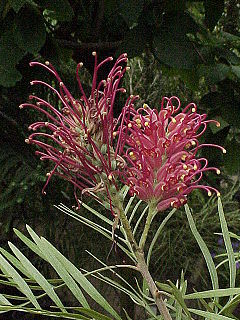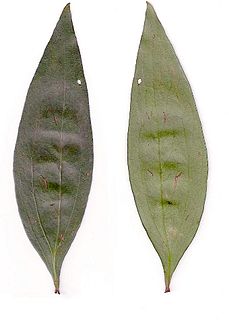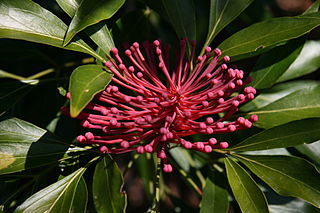
Grevillea is a diverse genus of about 360 species of evergreen flowering plants in the family Proteaceae, native to rainforest and more open habitats in Australia, New Guinea, New Caledonia, Sulawesi and other Indonesian islands east of the Wallace Line. It was named in honour of Charles Francis Greville, an 18th century patron of botany and co-founder of the Royal Horticultural Society. The species range from prostrate shrubs less than 50 cm (20 in) tall to trees 35 m (115 ft) tall. Common names include grevillea, spider flower, silky oak and toothbrush plant. Closely related to the genus Hakea, the genus gives its name to the subfamily Grevilleoideae.

Grevillea banksii, known by various common names including red silky oak, dwarf silky oak, Banks' grevillea, Byfield waratah and, in Hawaii, Kahili flower or Kahili tree. It is a plant of the large genus Grevillea in the diverse family Proteaceae. Native to Queensland, it has been a popular garden plant for many years though has been superseded somewhat horticulturally by smaller and more floriferous hybrids. A white-flowered form G. banksii fo. albiflora is known as white silky oak.
Athertonia is a genus of tall trees, constituting part of the plant family Proteaceae. It is a monotypic taxon, and the sole described species is Athertonia diversifolia, commonly known as Atherton oak. It is a small to medium-sized tree and is endemic to restricted tablelands and mountainous regions of the wet tropics rain forests of north-eastern Queensland, Australia, where it is widespread. For example, it grows in the Atherton Tableland region with which it shares its name, from the colonial pastoralist John Atherton (1837–1913). Its closest relatives are Heliciopsis and Virotia. A relative of the macadamia, it has potential as an ornamental tree and has an edible nut.

Alloxylon flammeum, commonly known as the Queensland tree waratah or red silky oak, is a medium-sized tree of the family Proteaceae found in the Queensland tropical rain forests of northeastern Australia. It has shiny green elliptical leaves up to 18 cm (7.2 in) long, and prominent orange-red inflorescences that appear from August to October, followed by rectangular woody seed pods that ripen in February and March. Juvenile plants have large deeply lobed pinnate leaves. Previously known as Oreocallis wickhamii, the initial specimen turned out to be a different species to the one cultivated and hence a new scientific name was required. Described formally by Peter Weston and Mike Crisp in 1991, A. flammeum was designated the type species of the genus Alloxylon. This genus contains the four species previously classified in Oreocallis that are found in Australasia.

Grevillea hilliana, of the plant family Proteaceae, is a species of Australian endemic trees known by many common names including white yiel yiel, white silky oak, grey oak, Hill's silky oak, and yill gill.
Grevillea glossadenia is a woody shrub or tree native to Queensland, in northeastern Australia. It is in the family Proteaceae.

Bellendena montana, commonly known as mountain rocket, is a species of low-growing multi-stemmed shrub in the plant family Proteaceae. It is endemic to high-altitude subalpine and alpine regions in Tasmania, Australia. The prominent white flower spikes appear over summer, followed by small bright red or yellow fruit in late summer and autumn.
Cardwellia is a genus of a sole described species of large trees in the plant family Proteaceae. The species Cardwellia sublimis is endemic to the rainforests of the wet tropics region of northeastern Queensland, Australia. Other common names include bull oak, golden spanglewood, lacewood, oak and oongaary. The compound leaves have up to 17 leaflets. It produces white inflorescences followed by woody fruits which are prominently displayed outside the canopy.

Stenocarpus salignus, known as the scrub beefwood is an Australian rainforest tree in the family Proteaceae. Found in warmer rainforests on the coast and ranges. It is often found in warm temperate rainforest on poorer sedimentary soils, or on volcanic soils above 750 metres above sea level. It was originally described by the botanist Robert Brown in 1810.
Stenocarpus cryptocarpus, known as the giant leaf stenocarpus, is a species of trees, of the plant family Proteaceae. They are endemic to some rainforest parts of the wet tropics region of north eastern Queensland, Australia. Notably, juvenile leaves of young trees may reach 115 cm (4 ft) in length.
Grevillea pteridifolia is a species of Grevillea native to Australia. Common names include silky grevillea, Darwin silky oak, ferny-leaved silky oak, fern-leaved grevillea, golden grevillea, golden tree and golden parrot tree. It occurs in Western Australia, Northern Territory, and Queensland.

Grevillea shiressii is an Australian shrub of the family Proteaceae endemic to New South Wales, where it is found in only two localities near Gosford.

Alloxylon pinnatum, known as Dorrigo waratah, is a tree of the family Proteaceae found in warm-temperate rainforest of south-east Queensland and northern New South Wales in eastern Australia. It has shiny green leaves that are either pinnate (lobed) and up to 30 cm (12 in) long, or lanceolate (spear-shaped) and up to 15 cm (5.9 in) long. The prominent pinkish-red flower heads, known as inflorescences, appear in spring and summer; these are made up of 50 to 140 individual flowers arranged in corymb or raceme. These are followed by rectangular woody seed pods, which bear two rows of winged seeds.

Grevillea parallela, also known as silver oak, beefwood or white grevillea, is a tree native to northern Australia.

Lomatia arborescens, commonly known as smooth lomatia or tree lomatia, is a shrub or small tree that grows at high altitudes, in and near rainforests. It is found north from the Barrington Tops area in eastern Australia.

Darlingia ferruginea, commonly known as the brown silky oak, is a rainforest tree of the family Proteaceae from Northern Queensland.

Buckinghamia celsissima, commonly known as the ivory curl, is a species of trees, constituting part of the plant family Proteaceae. They are endemic to the wet tropics rainforests areas of northeastern Queensland, Australia.

Opisthiolepis is a genus of a sole described species of large trees, constituting part of the plant family Proteaceae. The species Opisthiolepis heterophylla most commonly has the names of blush silky oak, pink silky oak, brown silky oak and drunk rabbit.

Placospermum is a genus of a single species of large trees, constituting part of the plant family Proteaceae. The species Placospermum coriaceum is endemic to the rainforests of the wet tropics region of northeastern Queensland, Australia. Common names include rose silky oak and plate-seeded oak.

Carnarvonia is a flowering plant genus of a single species, commonly named red oak or red silky oak and constituting part of the plant family Proteaceae. The single species named Carnarvonia araliifolia grows to large trees of 30 m (100 ft) or more. They grow naturally only (endemic) to the Wet Tropics rainforests region of north-eastern Queensland, Australia. The species has two described varieties, C. araliifolia var. araliifolia and C. araliifolia var. montana, and the common names are used for both.















